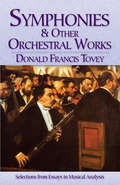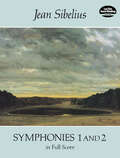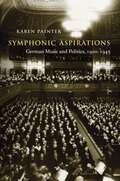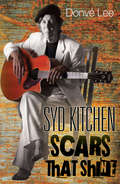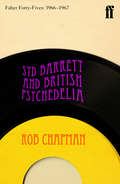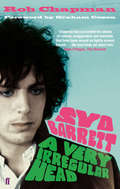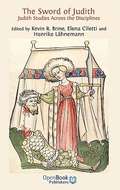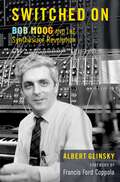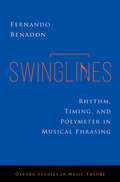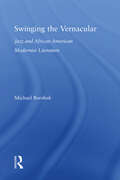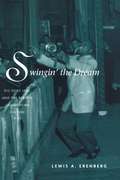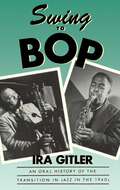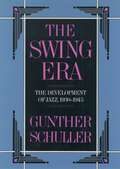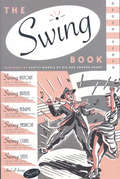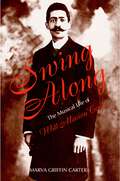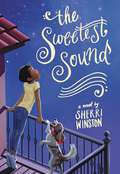- Table View
- List View
Symphonies and Other Orchestral Works: Selections from Essays in Musical Analysis
by Donald Francis ToveyMore than 100 selections from the noted musicologist's Essays in Musical Analysis cover most of the standard works in the symphonic repertory. Subjects include Beethoven's overtures and symphonies, including the author's famous study of the Ninth Symphony; all Brahms's overtures and symphonies; 11 symphonies by Haydn; six by Mozart; three symphonies each by Schubert, Schumann, and Sibelius; four symphonies by Dvoràk; and many other works by composers from Bach to Vaughan Williams.Donald Francis Tovey's Essays in Musical Analysis ranks among the English language's most acclaimed works of musical criticism. Praised for their acuteness, common sense, clarity, and wit, they offer entertaining and instructive reading for anyone interested in the classical music repertoire.
Symphonies 1 and 2: In Full Score
by Jean SibeliusFinland's greatest composer and a major figure in the development of Scandinavian music, Jean Sibelius (1865-1957) is admired for his complete mastery of symphonic form. Of the seven symphonies he composed, each differs greatly from the others, for Sibelius rarely approached the symphonic "problem" the same way. Each work seems committed to the thoughts, feelings, and logic of the movement.Sibelius's first two symphonies remain among his most accessible and popular. Of all his symphonic works, perhaps the First Symphony, composed in 1898-99, adheres most to classical form yet reflects the spirit of Nordic nationalism that came to be associated with the composer's music.The Second Symphony, perhaps his most expansive and melodious work in symphonic form, demonstrates Sibelius's increasing command of orchestral form and scoring. These two major works are reprinted here from the definitive full-score editions published by Breitkopf & Härtel, Leipzig.
Symphonien aus dem Geiste der Vokalmusik: Zur Finalgestaltung in der Symphonik im 18. und frühen 19. Jahrhundert
by Sascha WegnerImmer wieder wird in der Geschichte der Symphonie die Grenze zwischen Instrumental- und Vokalmusik durchbrochen. Auffallend häufig begegnen gerade in der Finalgestaltung vokalmusikalische Melodien, imaginäre Choräle oder ganze Chortableaus. Welche kompositorischen Strukturen und Ideen liegen ihnen zugrunde, welche kulturgeschichtliche Bedeutung kommt ihnen zu? Im Zentrum der Studie stehen exemplarische Untersuchungen, die sich einzelnen ‚vokalmusikalischen Modellen‘ widmen und dabei versuchen, ihre Bedingungen, Wirkungen und Geschichten ausführlicher zu würdigen.
Symphonic Aspirations: German Music and Politics, 1900-1945
by Karen PainterPainter examines the politicization of musical listening in Germany and Austria, showing how nationalism, anti-Semitism, liberalism, and socialism profoundly affected the experience of music. She draws on extensive writings on the symphony, particularly those of Mahler and Bruckner, to offer evidence that music can and did serve ideological ends.
Symphonic Aspirations: German Music and Politics, 1900–1945
by Karen PainterCan music be political? Germans have long claimed the symphony as a pillar of their modern national culture. By 1900, the critical discourse on music, particularly symphonies, rose to such prominence as to command front-page news. With the embrace of the Great War, the humiliation of defeat, and the ensuing economic turmoil, music evolved from the most abstract to the most political of the arts. Even Goebbels saw the symphony as a tool of propaganda. More than composers or musicians, critics were responsible for this politicization of music, aspiring to change how music was heard and understood. Once hailed as a source of individual heroism, the symphony came to serve a communal vision. Karen Painter examines the politicization of musical listening in Germany and Austria, showing how nationalism, anti-Semitism, liberalism, and socialism profoundly affected the experience of serious music. Her analysis draws on a vast collection of writings on the symphony, particularly those of Mahler and Bruckner, to offer compelling evidence that music can and did serve ideological ends. She traces changes in critical discourse that reflected but also contributed to the historical conditions of the fin de siècle, World War I, and the Nazi regime.
Syd Kitchen: Scars That Shine
by Donve LeeSkollie, saint, scholar, hippest of hippies, imperfect musician with a perfect imagination, Syd Kitchen was, like all great artists, born to enrich his art and not himself. Plagued by drugs, alcohol and depression, too much of an outlaw to be embraced by record companies, he frequently sold his furniture to cover production costs of his albums, seduced fans at concerts and music festivals worldwide with his dazzling Afro-Saxon mix of folk, jazz, blues and rock interspersed with marvellously irreverent banter, and finally became the subject of several compelling documentaries, one of which - Fool in a Bubble - premiered in New York in 2010. Syd Kitchen – Scars That Shine is a bittersweet romp through the life of a troubled musical genius. Although Syd passed away in 2011, the author Donve Lee climbs inside his head as he lies on his deathbed, and lets his life story unfold in his uniquely irreverent voice and the voices of a motley collection of friends and family.
Syd Barrett and British Psychedelia: Faber Forty-Fives: 1966–1967 (Faber Forty-Fives #1)
by Rob ChapmanSyd Barrett and British Psychedelia is an intimate snapshot of the years 1966-7, when the underground's house band, Pink Floyd, were cast blinking into the light of mainstream success. Nurtured in the progressive Cambridge scene and the bohemian hangouts of the Notting Hill Free School and UFO club, Pink Floyd pioneered a distinctly British mix of Victoriana, LSD-inflected mysticism, the avant-garde and pop. And at their heart was the gifted and complex songwriter, singer and guitarist Syd Barrett, who personified the psychedelic revolution in both its exoticism and its tragic impermanence.
Syd Barrett: A Very Irregular Head (Faber Forty-fives Ser. #1)
by Rob ChapmanSyd Barrett was the lead guitarist, vocalist, and principle songwriter in the original line up of Pink Floyd. During his brief time with the band (1966-68) he was the driving force behind the unit. After he left the band he made just two further solo albums which were both released in 1970, before withdrawing from public view to lead a quiet, and occasionally troubled life in Cambridge, the town of his birth. Rob Chapman's book is the first authoritative and exhaustively researched biography of Syd Barrett that fully celebrates his life and legacy as a musician, lyricist and artist, and which highlights the influence that he continues to have over contemporary bands and music fans alike.
The Sword of Judith: Judith Studies Across the Disciplines (PDF)
by Kevin R. Brine Elena Ciletti Henrike LähnemannThe Book of Judith tells the story of a fictitious Jewish woman beheading the general of a powerful army to free her people. The parabolic story was set as an example of how God will help the righteous. Judith's heroic action not only became a validating charter myth of Judaism itself but has also been appropriated by many Christian and secular groupings, and has been an inspiration for numerous literary texts and works of art. It continues to exercise its power over artists, authors and academics and is becoming a major field of research in its own right. The Sword of Judith is the first multidisciplinary collection of essays to discuss representations of Judith throughout the centuries. It transforms our understanding across a wide range of disciplines. The collection includes new archival source studies, the translation of unpublished manuscripts, the translation of texts unavailable in English, and Judith images and music.
Switched On: Bob Moog and the Synthesizer Revolution
by Albert GlinskyThe Moog synthesizer "bent the course of music forever" Rolling Stone declared. Bob Moog, the man who did that bending, was a lovable geek with Einstein hair and pocket protectors. He walked into history in 1964 when his homemade contraption unexpectedly became a sensation---suddenly everyone wanted a Moog. The Beatles, The Doors, The Byrds, and Stevie Wonder discovered his synthesizer, and it came to be featured in seminal film scores including Apocalypse Now and A Clockwork Orange. The Moog's game-changing sounds saturated 60's counterculture and burst into the disco party in the 70's to set off the electronic dance music movement. Bob had singlehandedly founded the synth industry and become a star in the process. But he was also going broke. Imitators copied his technology, the musicians' union accused him of replacing live players, and Japanese competitors started overtaking his work. He struggled to hang on to his inventions, his business, and his very name. Bob's story upends our notions of success and wealth, showing that the two don't always go together. In Switched On, author Albert Glinsky draws on exclusive access to Bob Moog's personal archives and his probing interviews with Bob's family and a multitude of associates, for this first complete biography of the man and his work. Switched On takes the reader on a roller coaster ride at turns triumphant, heart-breaking, and frequently laugh out loud absurd---a nuanced trip through the public and private worlds of this legendary inventor who altered the course of music.
Switched On: Bob Moog and the Synthesizer Revolution
by Albert GlinskyThe Moog synthesizer "bent the course of music forever" Rolling Stone declared. Bob Moog, the man who did that bending, was a lovable geek with Einstein hair and pocket protectors. He walked into history in 1964 when his homemade contraption unexpectedly became a sensation---suddenly everyone wanted a Moog. The Beatles, The Doors, The Byrds, and Stevie Wonder discovered his synthesizer, and it came to be featured in seminal film scores including Apocalypse Now and A Clockwork Orange. The Moog's game-changing sounds saturated 60's counterculture and burst into the disco party in the 70's to set off the electronic dance music movement. Bob had singlehandedly founded the synth industry and become a star in the process. But he was also going broke. Imitators copied his technology, the musicians' union accused him of replacing live players, and Japanese competitors started overtaking his work. He struggled to hang on to his inventions, his business, and his very name. Bob's story upends our notions of success and wealth, showing that the two don't always go together. In Switched On, author Albert Glinsky draws on exclusive access to Bob Moog's personal archives and his probing interviews with Bob's family and a multitude of associates, for this first complete biography of the man and his work. Switched On takes the reader on a roller coaster ride at turns triumphant, heart-breaking, and frequently laugh out loud absurd---a nuanced trip through the public and private worlds of this legendary inventor who altered the course of music.
Swinglines: Rhythm, Timing, and Polymeter in Musical Phrasing (OXFORD STUDIES IN MUSIC THEORY)
by Fernando BenadonThe way rhythm is taught in Western classrooms and music lessons is rooted in a centuries-old European approach that favors metric levels within a grand symmetrical grid. Swinglines encourages readers to experience rhythms, even gridded ones, as freewheeling affairs irrespective of the metric hierarchy. At its core, this book is a nuts-and-bolts study of durational comparisons in the context of creative expression. It shows that rhythms traditionally framed as "deviations" and "non-isochronous" have their own identities. They are coherent products of precise musical thought and action. Rather than situating them in the neither-here-nor-there, author Fernando Benadon takes a more inclusive view, one where isochrony and metric grids are shown as particular cases within the universe of musical time. Rhythms that do not readily comply with the metered regime are often regarded as anomalies and deformations. The music explored in this book demonstrates how readily this paradigm vanishes once the frame is flipped from what rhythm is not to what rhythm is. As conceptualized here, swing flattens the temporal field to consider how note values relate to one another by any magnitude, not just the simple ratios of traditional theory. Musical analyses illustrate the book's concepts with the aid of transcriptions and timing-data visualizations. Variation, tuplets, polymeter, displacement, phrase structure, rhythmic counterpoint, parallel tempos, cyclical patterns, and time signatures are shown to be particular expressions that draw their contours from the swing continuum. They showcase the rich diversity of rhythm and propose ways to reframe how we think about musical time.
Swinglines: Rhythm, Timing, and Polymeter in Musical Phrasing (OXFORD STUDIES IN MUSIC THEORY)
by Fernando BenadonThe way rhythm is taught in Western classrooms and music lessons is rooted in a centuries-old European approach that favors metric levels within a grand symmetrical grid. Swinglines encourages readers to experience rhythms, even gridded ones, as freewheeling affairs irrespective of the metric hierarchy. At its core, this book is a nuts-and-bolts study of durational comparisons in the context of creative expression. It shows that rhythms traditionally framed as "deviations" and "non-isochronous" have their own identities. They are coherent products of precise musical thought and action. Rather than situating them in the neither-here-nor-there, author Fernando Benadon takes a more inclusive view, one where isochrony and metric grids are shown as particular cases within the universe of musical time. Rhythms that do not readily comply with the metered regime are often regarded as anomalies and deformations. The music explored in this book demonstrates how readily this paradigm vanishes once the frame is flipped from what rhythm is not to what rhythm is. As conceptualized here, swing flattens the temporal field to consider how note values relate to one another by any magnitude, not just the simple ratios of traditional theory. Musical analyses illustrate the book's concepts with the aid of transcriptions and timing-data visualizations. Variation, tuplets, polymeter, displacement, phrase structure, rhythmic counterpoint, parallel tempos, cyclical patterns, and time signatures are shown to be particular expressions that draw their contours from the swing continuum. They showcase the rich diversity of rhythm and propose ways to reframe how we think about musical time.
Swinging the Vernacular: Jazz and African American Modernist Literature
by Michael BorshukThis book looks at the influence of jazz on the development of African American modernist literature over the 20th century, with a particular attention to the social and aesthetic significance of stylistic changes in the music.
Swinging the Vernacular: Jazz and African American Modernist Literature
by Michael BorshukThis book looks at the influence of jazz on the development of African American modernist literature over the 20th century, with a particular attention to the social and aesthetic significance of stylistic changes in the music.
Swingin' the Dream: Big Band Jazz and the Rebirth of American Culture
by Lewis A. ErenbergDuring the 1930s, swing bands combined jazz and popular music to create large-scale dreams for the Depression generation, capturing the imagination of America's young people, music critics, and the music business. Swingin' the Dream explores that world, looking at the racial mixing-up and musical swinging-out that shook the nation and has kept people dancing ever since. "Swingin' the Dream is an intelligent, provocative study of the big band era, chiefly during its golden hours in the 1930s; not merely does Lewis A. Erenberg give the music its full due, but he places it in a larger context and makes, for the most part, a plausible case for its importance."—Jonathan Yardley, Washington Post Book World "An absorbing read for fans and an insightful view of the impact of an important homegrown art form."—Publishers Weekly "[A] fascinating celebration of the decade or so in which American popular music basked in the sunlight of a seemingly endless high noon."—Tony Russell, Times Literary Supplement
Swingin' the Dream: Big Band Jazz and the Rebirth of American Culture
by Lewis A. ErenbergDuring the 1930s, swing bands combined jazz and popular music to create large-scale dreams for the Depression generation, capturing the imagination of America's young people, music critics, and the music business. Swingin' the Dream explores that world, looking at the racial mixing-up and musical swinging-out that shook the nation and has kept people dancing ever since. "Swingin' the Dream is an intelligent, provocative study of the big band era, chiefly during its golden hours in the 1930s; not merely does Lewis A. Erenberg give the music its full due, but he places it in a larger context and makes, for the most part, a plausible case for its importance."—Jonathan Yardley, Washington Post Book World "An absorbing read for fans and an insightful view of the impact of an important homegrown art form."—Publishers Weekly "[A] fascinating celebration of the decade or so in which American popular music basked in the sunlight of a seemingly endless high noon."—Tony Russell, Times Literary Supplement
Swingin' the Dream: Big Band Jazz and the Rebirth of American Culture
by Lewis A. ErenbergDuring the 1930s, swing bands combined jazz and popular music to create large-scale dreams for the Depression generation, capturing the imagination of America's young people, music critics, and the music business. Swingin' the Dream explores that world, looking at the racial mixing-up and musical swinging-out that shook the nation and has kept people dancing ever since. "Swingin' the Dream is an intelligent, provocative study of the big band era, chiefly during its golden hours in the 1930s; not merely does Lewis A. Erenberg give the music its full due, but he places it in a larger context and makes, for the most part, a plausible case for its importance."—Jonathan Yardley, Washington Post Book World "An absorbing read for fans and an insightful view of the impact of an important homegrown art form."—Publishers Weekly "[A] fascinating celebration of the decade or so in which American popular music basked in the sunlight of a seemingly endless high noon."—Tony Russell, Times Literary Supplement
Swingin' the Dream: Big Band Jazz and the Rebirth of American Culture
by Lewis A. ErenbergDuring the 1930s, swing bands combined jazz and popular music to create large-scale dreams for the Depression generation, capturing the imagination of America's young people, music critics, and the music business. Swingin' the Dream explores that world, looking at the racial mixing-up and musical swinging-out that shook the nation and has kept people dancing ever since. "Swingin' the Dream is an intelligent, provocative study of the big band era, chiefly during its golden hours in the 1930s; not merely does Lewis A. Erenberg give the music its full due, but he places it in a larger context and makes, for the most part, a plausible case for its importance."—Jonathan Yardley, Washington Post Book World "An absorbing read for fans and an insightful view of the impact of an important homegrown art form."—Publishers Weekly "[A] fascinating celebration of the decade or so in which American popular music basked in the sunlight of a seemingly endless high noon."—Tony Russell, Times Literary Supplement
Swing To Bop: An Oral History Of The Transition In Jazz In The 1940s
by Ira GitlerThis indispensable book brings us face to face with some of the most memorable figures in jazz history and charts the rise and development of bop in the late 1930s and '40s. Ira Gitler interviewed more than 50 leading jazz figures, over a 10-year period, to preserve for posterity their recollections of the transition in jazz from the big band era to the modern jazz period. The musicians interviewed, including both the acclaimed and the unrecorded, tell in their own words how this renegade music emerged, why it was a turning point in American jazz, and how it influenced their own lives and work. Placing jazz in historical context, Gitler demonstrates how the mood of the nation in its post-Depression years, racial attitudes of the time, and World War II combined to shape the jazz of today.
Swing to Bop: An Oral History of the Transition in Jazz in the 1940s
by Ira GitlerThis indispensable book brings us face to face with some of the most memorable figures in jazz history and charts the rise and development of bop in the late 1930s and '40s. Ira Gitler interviewed more than 50 leading jazz figures, over a 10-year period, to preserve for posterity their recollections of the transition in jazz from the big band era to the modern jazz period. The musicians interviewed, including both the acclaimed and the unrecorded, tell in their own words how this renegade music emerged, why it was a turning point in American jazz, and how it influenced their own lives and work. Placing jazz in historical context, Gitler demonstrates how the mood of the nation in its post-Depression years, racial attitudes of the time, and World War II combined to shape the jazz of today.
The Swing Era: The Development of Jazz, 1930-1945 (The History of Jazz)
by Gunther SchullerHere is the book jazz lovers have eagerly awaited, the second volume of Gunther Schuller's monumental The History of Jazz. When the first volume, Early Jazz, appeared two decades ago, it immediately established itself as one of the seminal works on American music. Nat Hentoff called it "a remarkable breakthrough in musical analysis of jazz," and Frank Conroy, in The New York Times Book Review, praised it as "definitive.... A remarkable book by any standard...unparalleled in the literature of jazz." It has been universally recognized as the basic musical analysis of jazz from its beginnings until 1933. The Swing Era focuses on that extraordinary period in American musical history--1933 to 1945--when jazz was synonymous with America's popular music, its social dances and musical entertainment. The book's thorough scholarship, critical perceptions, and great love and respect for jazz puts this well-remembered era of American music into new and revealing perspective. It examines how the arrangements of Fletcher Henderson and Eddie Sauter--whom Schuller equates with Richard Strauss as "a master of harmonic modulation"--contributed to Benny Goodman's finest work...how Duke Ellington used the highly individualistic trombone trio of Joe "Tricky Sam" Nanton, Juan Tizol, and Lawrence Brown to enrich his elegant compositions...how Billie Holiday developed her horn-like instrumental approach to singing...and how the seminal compositions and arrangements of the long-forgotten John Nesbitt helped shape Swing Era styles through their influence on Gene Gifford and the famous Casa Loma Orchestra. Schuller also provides serious reappraisals of such often neglected jazz figures as Cab Calloway, Henry "Red" Allen, Horace Henderson, Pee Wee Russell, and Joe Mooney. Much of the book's focus is on the famous swing bands of the time, which were the essence of the Swing Era. There are the great black bands--Duke Ellington, Count Basie, Jimmie Lunceford, Earl Hines, Andy Kirk, and the often superb but little known "territory bands"--and popular white bands like Benny Goodman, Tommy Dorsie, Artie Shaw, and Woody Herman, plus the first serious critical assessment of that most famous of Swing Era bandleaders, Glenn Miller. There are incisive portraits of the great musical soloists--such as Art Tatum, Teddy Wilson, Coleman Hawkins, Lester Young, Bunny Berigan, and Jack Teagarden--and such singers as Billie Holiday, Frank Sinatra, Peggy Lee, and Helen Forest.
The Swing Book
by Degen PenerDocuments the history of swing music and dancing, covering the important artists, style and fashion, albums, and dance moves of swing
Swing Along: The Musical Life of Will Marion Cook
by Marva CarterRenowned today as a prominent African-American in Music Theater and the Arts community, composer, conductor, and violinist Will Marion Cook was a key figure in the development of American music from the 1890s to the 1920s. In this insightful biography, Marva Griffin Carter offers the first definitive look at this pivotal life's story, drawing on both Cook's unfinished autobiography and his wife Abbie's memoir. A violin virtuoso, Cook studied at Oberlin College (his parents' alma mater), Berlin's Hochschule für Musik with Joseph Joachim, and New York's national Conservatory of Music with Antonin Dvorak. Cook wrote music for a now-lost production of Uncle Tom's Cabin for the Chicago World's Fair of 1893, and then devoted the majority of his career to black musical comedies due to limited opportunities available to him as a black composer. He was instrumental in showcasing his Southern Syncopated Orchestra in the prominent concert halls of the Unites States and Europe, even featuring New Orleans clarinetist Sidney Bechet, who later introduced European audiences to authentic blues. Once mentored by Frederick Douglas, Will Marion Cook went on to mentor Duke Ellington, paving the path for orchestral concert jazz. Through interpretive and musical analyses, Carter traces Cook's successful evolution from minstrelsy to musical theater. Written with his collaborator, the distinguished poet Paul Lawrence Dunbar, Cook's musicals infused American Musical Theater with African-American music, consequently altering the direction of American popular music. Cook's In Dahomey, hailed by Gerald Bordman as "one of the most important events in American Musical Theater history," was the first full-length Broadway musical to be written and performed by blacks. Alongside his accomplishments, Carter reveals Cook's contentious side- a man known for his aggressiveness, pride, and constant quarrels, who became his own worst enemy in regards to his career. Carter further sets Cook's life against the backdrop of the changing cultural and social milieu: the black theatrical tradition, white audiences' reaction to black performers, and the growing consciousness and sophistication of blacks in the arts, especially music.
The Sweetest Sound
by Sherri WinstonA story of family, faith, and following your heart For ten-year-old Cadence Jolly, birthdays are a constant reminder of all that has changed since her mother skipped town with dreams of becoming a singing star. Cadence inherited that musical soul, she can't deny it, but otherwise she couldn't be more different - she's as shy as can be. She did make a promise last year that she would try to break out of her shell, just a little. And she prayed that she'd get the courage to do it. As her eleventh birthday draws near, she realizes time is running out. And when a secret recording of her singing leaks and catches the attention of her whole church, she needs to decide what's better: deceiving everyone by pretending it belongs to someone else, or finally stepping into the spotlight. In a story filled with whimsy and hope, Sherri Winston inspires readers to embrace the voice within.
